Grapefruit-sized hail? Climate change could bring giant ice stones
A new study published this week may cause a collective groan among those who’ve had a car dented or a windshield shattered by large hailstones.
Expect to see larger hail and more intense hailstorms in the future as the world warms, especially in the Eastern U.S., according to a study published Wednesday in the Nature journal “npj Climate and Atmospheric Science.”
The study modeled how hailstones of the past could compare to those of the future, using two scenarios for potential greenhouse gas emissions. The result?
“Hailstones larger than two inches get larger,” said study co-author Victor Gensini, an associate professor and meteorologist at Northern Illinois University and one of the nation's leading experts on storms and tornadoes. The higher the emissions, he said, the greater the size of the hailstones, with the hail largest and most frequent in the worst-case scenario.
Warmer temperatures are forecast to create more of the updrafts in thunderstorms that create bigger hail, Gensini and co-authors reported. Smaller hail is projected to decrease because it’s more likely to melt in the warmer air as it nears the surface, he said, while larger hail, falling at a faster velocity, will be less affected.
“If you want to create a large hailstone, you really need a strong updraft,” Gensini said. “If you point a hair dryer on end up into the sky, it’s pretty easy to balance like a ping pong ball on that hair dryer, right? If you want to balance a grapefruit, you need a much stronger hair dryer.”
The warmer temperatures are projected to increase the instability in the environment, helping to build the stronger updrafts that form large thunderstorms and supercells. It’s the updrafts that loft rain drops high up into the storm to form and grow hailstones.
Warmer temperatures also allow more water vapor in the atmosphere, thus energizing storms and providing more moisture.
The hail study projects fewer days with severe hailstorms across the High Plains, and more hail days with bigger hail outside of the southern plains, particularly in the Midwest, Ohio Valley and Northeast. Gensini and others have reported similar changes occurring with severe convective storms and tornadoes. More tornadoes are occurring farther east and outside traditional tornado seasons.

What makes a hailstone?
Hail begins when raindrops are carried up inside a storm to colder areas of the atmosphere where they freeze. But exactly what happens to turn those drops into record-setting hailstones? For example, the hailstone that fell in Vivian, South Dakota on June 3, 2010, and measured 8 inches across.
Scientists are still working to fully understand that, said Matthew Kumjian, a professor of meteorology at Penn State who was not a co-author on the new study. For example, he said, “a hot topic of research” is how the supercooling of liquids works high up in storms and how the liquids interact with particles and dissolved particles in the cloud to form ice crystals.
Just like baking a cake, Kumjian said, they know certain ingredients are needed to produce big hail: strong updrafts, super cooled liquids and residence time, meaning conditions inside the storm that allow a hailstone to stay in the clouds longer.
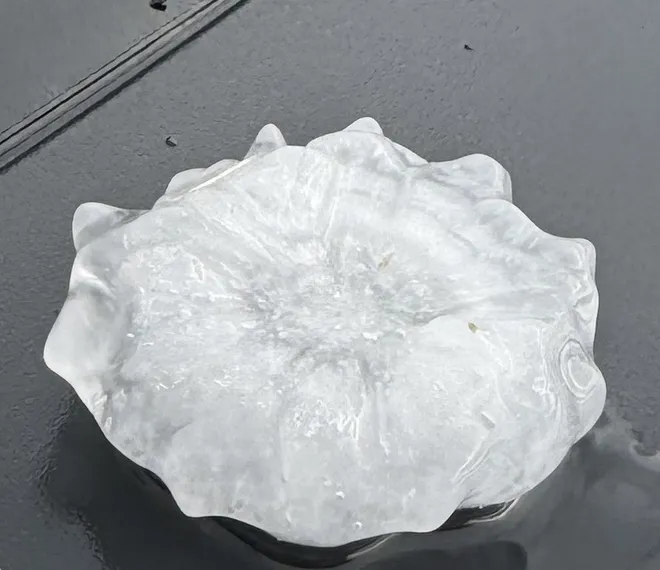
What makes a hailstone grow?
Big rotating supercell thunderstorms produce the lion’s share of large hail, Gensini said.
Supercells are a type of large thunderstorm with a rotating vortex of air, which can be tens of thousands of feet high. In the future, he said, stronger thunderstorms, with stronger upward motion can provide the upward accelerations of air that produce more hail.
A hailstone grows larger when other drops freeze onto its surface while it is inside an updraft, creating growth layers and the knobby appearance that big stones get as they spin and tumble in the clouds. The longer a stone remains in the storm, the bigger it can get.
Two things are thought to control the residence time: the strength of the updrafts and the speed and direction of the curving, horizontal winds inside the updraft, Kumjian said. Once the stone is no longer supported by the updraft, it begins falling, but it can continue to grow until it hits a temperature above freezing.
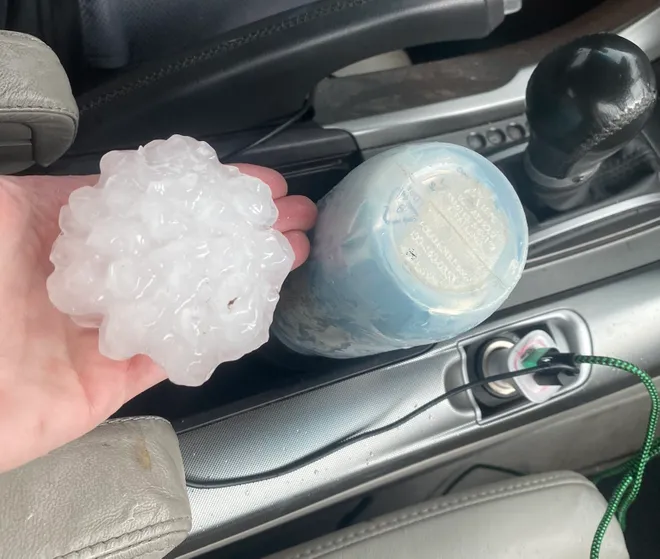
Hail:How it forms and why it's destructive
How big could hailstones get?
“That’s the million-dollar question,” Kumjian said. So far, the world-record hailstone was found in Bangladesh in 1986, weighing in at just over 2 pounds.
Although they’re still trying to understand the processes that control hail size, he said model simulations show the maximum weight a hailstone is likely to reach is 3 pounds.
Using “a huge database” of real hailstone shapes to look at how mass, shape and size are related, they found a hailstone in the typical roundish shape could reach roughly 10 inches in diameter, slightly bigger than an NBA basketball.
Hail:How hailstones form and why they're destructive
Hail is an increasingly expensive problem
Hail happens somewhere in the United States on average 158 days a year, but has typically been considered a secondary peril by the insurance industry, Gensini said.
Given that annual losses from hail damage and severe convective storms are in the multi-billions and five times higher than in 2008, hail and storms are “becoming a primary peril very quickly,” he said. “This year, we’re already up to at least $60 billion in insured losses due to convective storms.”
It’s not just the size or frequency of hail that’s the problem, said Walker Ashley, a meteorologist and professor at Northern Illinois University and a co-author on the hail study. It’s where the hail falls.
“We continue to balloon our population, but it’s not just density,” Ashley said. It’s the spreading out of the population into previously rural areas that’s driving the billions in losses.
Hail damage doesn’t generally occur in big multi-billion-dollar events. “It’s really because we’re seeing death by 1,000 paper cuts,” Ashley said. "It’s $2 million in damages in one place and $10 million in another."
The greater risk for more significant hail, coupled with the expanding footprint of society means the already escalating economic costs will continue to climb, he said.

Is hailstone size already increasing?
It’s too soon to say there’s a definitive trend.
“Many of us would argue in the climate and severe weather community that over the last couple of years, we are seeing this kind of eastward expansion of severe weather activity,” Gensini said.
During the first quarter of 2024 there were 93 reports of large hail, greater than 2 inches in size compared to 57 last year and a 20-year average of 50, according to a summary by Gallagher Re, a reinsurance firm.
More research is needed to fully understand what’s happening in hail storms, Kumjian said. “We are still trying to understand the environments and how they control hail size and storm processes.
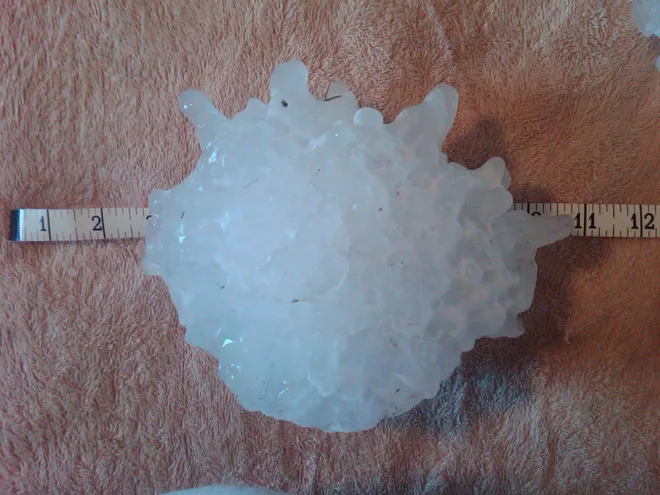
What's the largest hailstone on record in the U.S.?
According to the University Corporation for Atmospheric Research, if ranked by diameter the hailstones fall in this order. When ranking by circumference, the Nebraska hail stone would be first.
- Vivian, South Dakota, July 23, 2010: 31 ounces, 8 inches in diameter and 18.6 inches in circumference.
- Aurora Nebraska, June 22, 2003: 7 inches in diameter and 18.75 inches in circumference. Weight not available.
- Coffeyville, Kansas, Sept. 3, 1970: 27 ounces, 5.7 inches in diameter and 17.5 inches in circumference.
- Potter, Nebraska, July 12, 1928: 24 ounces, 5.4 inches in diameter.
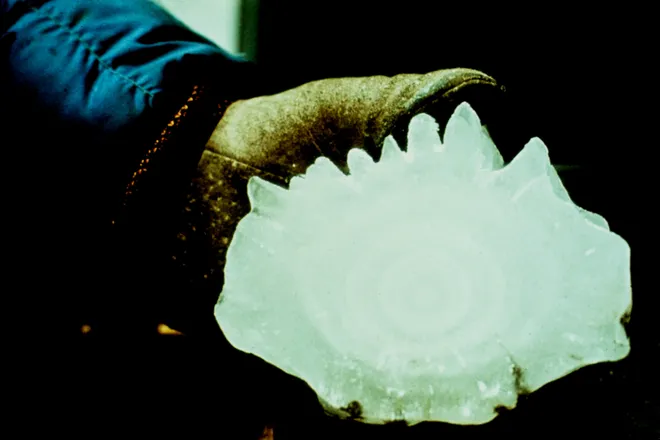
What are the standard comparisons to estimate hail size?
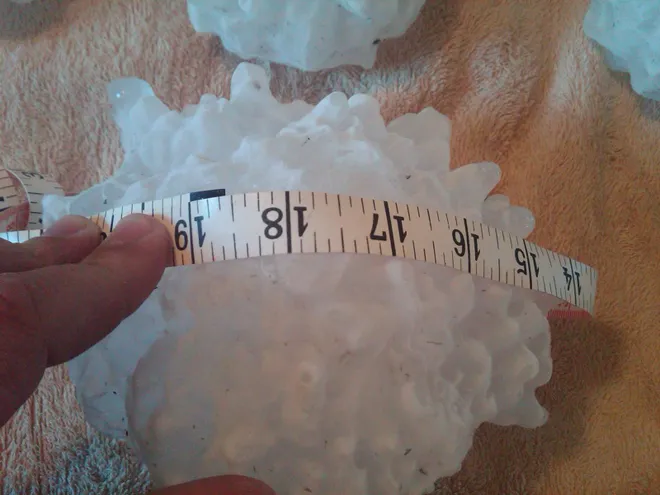
Sizes estimated in inches in diameter
- Pea - .25
- Mothball - .5
- Penny - .75
- Nickel - .875
- Quarter - 1
- Ping pong ball - 1.5
- Golf ball - 1.75
- Tennis ball - 2.5
- Baseball - 2.75
- Tea cup - 3 inches
- Softball - 4 inches
- Grapefruit - 4.5 inches
Dinah Voyles Pulver covers climate change and the environment for USA TODAY. She's been writing about hurricanes, tornadoes and violent weather for more than 30 years. Reach her at dpulver@gannett.com or @dinahvp.
Disclaimer: The copyright of this article belongs to the original author. Reposting this article is solely for the purpose of information dissemination and does not constitute any investment advice. If there is any infringement, please contact us immediately. We will make corrections or deletions as necessary. Thank you.



